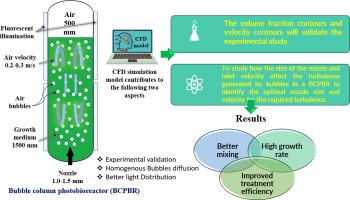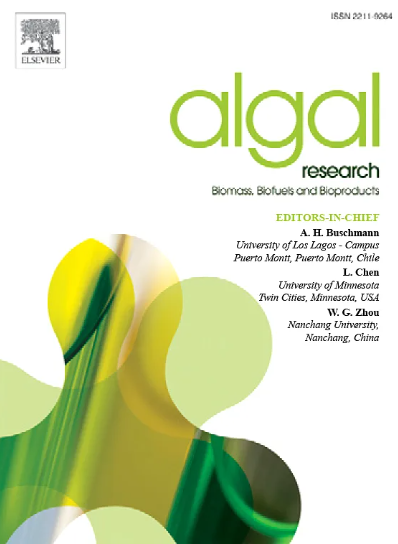Computational fluid dynamics (CFD) simulation modeling for the cultivation of microalgal monoculture in axenic enclosed bubble column photobioreactor (BCPBR)
IF 4.6
2区 生物学
Q1 BIOTECHNOLOGY & APPLIED MICROBIOLOGY
Algal Research-Biomass Biofuels and Bioproducts
Pub Date : 2024-10-01
DOI:10.1016/j.algal.2024.103725
引用次数: 0
Abstract
Researchers are more concerned with axenic-enclosed PBRs, where there is less or no chance of contamination during the production of biochemical and highly valuable metabolites, and monocultures of microalgae are being grown more frequently. It is a closed, manufactured vessel that aids in the photosynthesis of microalgal cells using artificial light or sunlight as the energy source. In this study, the bubble column PBR (BCPBR) was selected because it possessed some advantages over other PBRs for the growth of Chlorella vulgaris. The BCPBR system prevents contact between the enclosed microalgal cells and the environment, allowing the culturing of microalgae species that are difficult to grow in open pond systems. To compare BCPBR performance quantitatively, the efficient mixing expected in BCPBR, as discussed in the literature, was applied to the CFD model. The experimental results observed during the cultivation of C. vulgaris with restaurant wastewater (RWW) in BCPBR clearly showed better mixing, high growth, and improved treatment efficiency. CFD analysis was conducted on the evolution of bubbles in the BCPBR. The Pressure-Implicit with Splitting of Operators (PISO) pressure correction method is used for velocity and pressure coupling. A geo-reconstruct approach is used to construct the interface, and a second-order upwind calculation technique is used to determine the flow parameters. Therefore, CFD simulation in this study will contribute to the following aspects: (i) the volume fraction contours and velocity contours are going to validate the experimental study as the homogenous mixing favors the growth and productivity, (ii) To study how the size of the nozzle and inlet velocity affect the turbulence generated by bubbles in a BCPBR to identify the optimal nozzle size and velocity for the required turbulence.

在轴向封闭式气泡柱光生物反应器(BCPBR)中培养单一微藻的计算流体动力学(CFD)模拟模型
研究人员更关注的是轴向封闭式 PBR,因为在生产生化和高价值代谢物的过程中,受到污染的机会较少或没有污染,而且微藻的单培也越来越频繁。它是一种封闭的人造容器,利用人造光或太阳光作为能源,帮助微藻细胞进行光合作用。在本研究中,之所以选择气泡柱 PBR(BCPBR),是因为与其他 PBR 相比,它在普通小球藻的生长方面具有一些优势。BCPBR 系统可防止封闭的微藻细胞与环境接触,从而可以培养难以在开放池塘系统中生长的微藻物种。为了定量比较 BCPBR 的性能,我们将文献中讨论的 BCPBR 中预期的高效混合应用于 CFD 模型。在 BCPBR 中用餐饮废水(RWW)培养粗毛藻时观察到的实验结果清楚地表明,混合效果更好,粗毛藻生长旺盛,处理效率提高。对 BCPBR 中气泡的演变进行了 CFD 分析。速度和压力耦合采用了压力-隐含运算器分割(PISO)压力校正方法。采用地理重构法构建界面,并使用二阶上风计算技术确定流动参数。因此,本研究中的 CFD 模拟将在以下方面做出贡献:(i) 体积分数等值线和速度等值线将验证实验研究,因为均匀混合有利于气泡的生长和生产率;(ii) 研究喷嘴尺寸和入口速度如何影响 BCPBR 中气泡产生的湍流,以确定所需湍流的最佳喷嘴尺寸和速度。
本文章由计算机程序翻译,如有差异,请以英文原文为准。
求助全文
约1分钟内获得全文
求助全文
来源期刊

Algal Research-Biomass Biofuels and Bioproducts
BIOTECHNOLOGY & APPLIED MICROBIOLOGY-
CiteScore
9.40
自引率
7.80%
发文量
332
期刊介绍:
Algal Research is an international phycology journal covering all areas of emerging technologies in algae biology, biomass production, cultivation, harvesting, extraction, bioproducts, biorefinery, engineering, and econometrics. Algae is defined to include cyanobacteria, microalgae, and protists and symbionts of interest in biotechnology. The journal publishes original research and reviews for the following scope: algal biology, including but not exclusive to: phylogeny, biodiversity, molecular traits, metabolic regulation, and genetic engineering, algal cultivation, e.g. phototrophic systems, heterotrophic systems, and mixotrophic systems, algal harvesting and extraction systems, biotechnology to convert algal biomass and components into biofuels and bioproducts, e.g., nutraceuticals, pharmaceuticals, animal feed, plastics, etc. algal products and their economic assessment
 求助内容:
求助内容: 应助结果提醒方式:
应助结果提醒方式:


